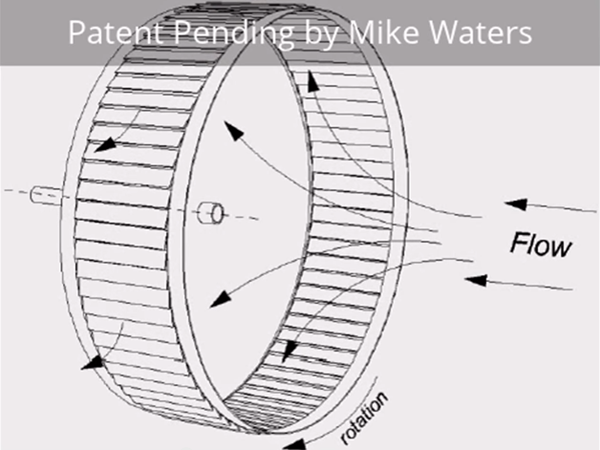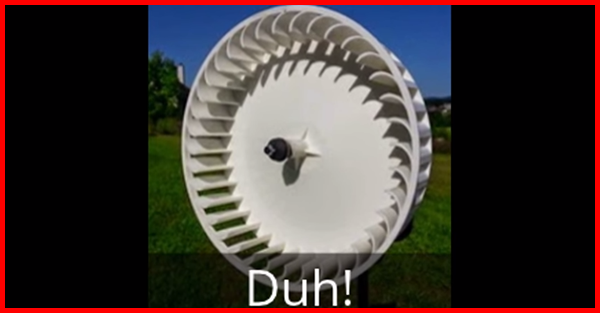.
A Ridiculously Simple Wind Turbine That Is 5 to 20 Times More Efficient Than A 3 Bladed Wind Turbine
Mike Water’s design is basically a squirrel cage arrangement set 90-degrees perpendicular to the incoming air, diverting all the incoming air to the perimeter where the highest torque can be generated.
Put another way the further away from the rotational axis you are the greater the torque you can generate.

Furthermore, Mike says that even the “drag” effect contributes rather than diminishes in this design, much like a ridge accelerates air flow. A good analogy for this is when you are driving on the freeway close behind a semi-truck, your mileage improves, not just from his breaking the wind but because he is actually pulling you to a certain extent, so his mileage goes down.
Also, Mike’s turbine will start rotating at less than 1 mph wind — so slight that you can’t even tell there is a breeze.
Compare Mike’s design to the typical three-bladed turbine you see deployed in most commercial applications nowadays. At low speed, most of the wind (like 95%) misses the blades, and the bulk of the blade is near to point of rotation, where the least torque is.
But a NASA aerodynamicist tested the design for several months, and someone from the audience at his Global BEM lecture built another prototype. What they found, independently, was so unbelievable that Mike didn’t dare tell us the numbers until he had more corroboration. He certainly did not want me making any announcements until further validation.
I met the second guy at the Tesla Tech conference in July, who repeated to me what Mike had told us in private.
Using a wind tunnel to compare Mike’s design to the conventional 3-blade design, they were getting numbers like 50x more efficient. FIFTY TIMES!!
In the wind industry, if you can get 5% improvement, you’ll be making all kinds of friends and business deals. Mike’s exhibits ONE THOUSAND TIMES MORE IMPROVEMENT THAN THAT!
Geoff told of an early demonstration he saw Mike do inside a car. He had the person turn their heater blower to full, and he placed a 3-bladed turbine in front if it, and it barely turned. Then he had them turn the blower to its lowest setting, and he took a similar diameter turbine of his squirrel cage design and held it back about 2-3 feet, and it was spinning rapidly from that low air flow.
What this means is that the size of the turbine can be much smaller to perform the same amount of energy harvesting as the much larger and cumbersome three-bladed design. You could easily transport and assemble this design and it can be used as a wind or water turbine.
Furthermore, the design is potentially much sturdier, hence able to hold up to high winds.
.
A Video And A DIY Version On The Next Page
.
Next Page »






Denis Ouellette
Jul 07. 2015
HI, is there a way to contact Mike Waters? since he has a patent pending, I think it might be better to talk in a less public venue….. I might have some positive criticisms that he might like to discuss privately…
Thanks
Denis “the Grizz” Ouellette
Dan Bartmann
Jul 10. 2015
Stupid, Ignorant… or intentionally trying to mislead the uninformed? Bunk reporting… bunk science. Simple physics tells us that… conventional wind turbine design does not afford a 10% improvement in efficiency. The squirrel cage fan… a revolutionary ‘new’ idea (really??) I am sorry, but this whole article wastes peoples time, misinforms them and it’s not true. This is aweful. I love wind energy, I understand the basic physics. In this day and age we should be educating folks, not misleading them. Boo on greenergyjubilation.com for being part of the problem not the solution in this case.
锛?鈽嗏槄銉┿儍銉斻兂銈扮劇鏂欌槄鈽?锛娾枲鈼嗗嵆绱嶁梿鈻犮€愰€佹枡鐒℃枡銆戙€怌OACH 銈炽兗銉併€戙偟銈ゃ儠 闀疯病甯?銈偡銉ャ儸銈?銈广偒銉笺儠 銉椼儶銉炽儓 銈搞儍銉?銈
Jan 23. 2016
Wonderful post but I was wondering if you could write a litte more on this topic? I’d be very thankful if you could elaborate a little bit further. Thank you!
Gary Brown
Mar 07. 2016
Mike,
A few years ago I was asked to test and supply data for a very similar wind design by a couple of dentists near the East Coast. I informed them of my concerns for this design with respect to wind applications. They were not to be deterred and I accepting the task.. I fabricated a 48″ experimental model and began to test it as I would any of the other VAWT or HAWT designs I had tested.
As with many designs it worked well, but only in a very narrow wind speed band. Exceptionally narrow. So narrow in fact it was very difficult to derive good data in a dynamic test environment..
The explanation for the phenomenon came from design and test data on squirrel cage fans. The fan is specifically designed to be very efficient at constant motor speeds. These speeds are selected to match the fan blade. When the air moves across the fan at speeds outside this narrow wind speed band, the system becomes very inefficient. This is due to several factors such as cavitation and interruptions in laminar air flow.
Never stop thinking